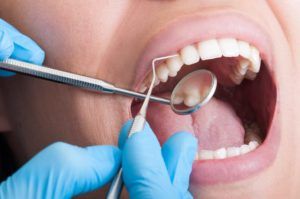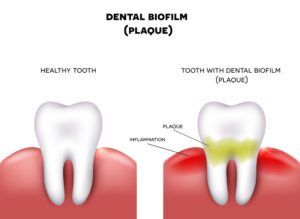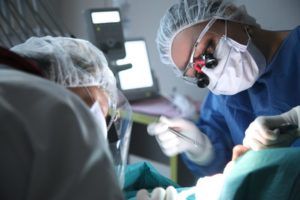
Periodontal Scaling & Root Planing
Periodontal scaling and root planing are procedures used to treat periodontal disease. Thought of by many as a ‘deep cleaning’, this in-office procedure involves the careful removal of hardened plaque near the gum line, where harmful bacteria can grow and cause damage to both the hard and soft tissues of the mouth. The treatment starts with scaling, during which special instruments are used to scrape tartar away from the teeth and gums. Root planing follows, which is a process of smoothing the surface of the tooth’s root in order to prevent bacteria from accumulating there in the future. Finally, an antibiotic is administered to ensure that no bacteria remain at the treatment site.
Continue Reading...
Causes of Periodontal Disease
Periodontal disease is common among dental patients and is the leading cause of tooth loss among American adults. It develops as the result of an accumulation of harmful bacteria harbored in hardened plaque on the teeth both above and beneath the gum line. Plaque is usually brushed or flossed away; but plaque allowed to remain […]
Continue Reading...
Gingivitis & Periodontitis
Gingivitis and periodontitis are gum diseases caused by a proliferation of bacteria along and beneath the periodontal tissues. Gingivitis is the mildest form of periodontal disease, beginning with minor symptoms like gum inflammation. Although it is highly treatable, gingivitis is often left untreated and allowed to progress into an advanced stage of a periodontal disease […]
Continue Reading...
Periodontal Bone Graft
Most cases of periodontal disease are treatable using minimally invasive procedures, such as scaling and root planing or gum surgery. However, a periodontal disease that has been allowed to progress can result in deteriorated bone beneath the gums. When bone is destroyed by gum disease, it can no longer adequately support the teeth, eventually leading […]
Continue Reading...
Crown Lengthening
Crown lengthening is a very common procedure used for functional and cosmetic purposes. In restorative dentistry, crown lengthening is used to prepare the teeth for dental restorations, such as caps and crowns, which require a sufficient amount of tooth structure above the gum line in order to support new restorations. Other patients may elect to […]
Continue Reading...
Non-Surgical Gum Treatments
There is a wide range of procedures at the disposal of periodontists for the treatment of periodontal diseases and conditions. When multiple treatment choices are available, the American Academy of Periodontology supports the use of the most minimally invasive and cost-efficient option. Often, this means that patients can undergo non-surgical treatments to restore periodontal health. […]
Continue Reading...
What is Periodontal Disease?
Periodontal disease is a highly common infection of the periodontal tissues (gums and bone) that are responsible for supporting the teeth. These infections are caused by bacteria that grow on the teeth near the gum line due to poor brushing and flossing practices. Periodontal disease is known as gingivitis during its earliest stages, which is […]
Continue Reading...
Types of Periodontal Disease
Periodontal disease is one of the most common diseases in America, affecting nearly 65 million adults over age 30. There are two types of periodontal disease – gingivitis and periodontitis. Each refers to an accumulation of bacteria along the gum line though one is more severe than the other. Gingivitis – the least invasive form of […]
Continue Reading...
Signs & Symptoms of Periodontal Disease
Periodontal disease – also known as gingivitis and periodontitis – is most easily identified by the visible symptoms it causes as it progresses. In its beginning stages, a periodontal disease often causes no symptoms at all, making it difficult for the average person to notice. With time, bacteria begin causing inflammation in the gums, which […]
Continue Reading...
Gum Surgery
Periodontists treat their patients with the most conservative measures possible, but sometimes surgery is necessary to facilitate oral health and aesthetics. Some of the reasons your periodontist may recommend gum surgery include: To restore gum tissues lost to periodontal disease. Also known as guided tissue regeneration, this procedure is often combined with bone grafting to […]
Continue Reading...
What is a Periodontist?
A periodontist is a dentist who has undergone additional specialty training beyond dental school pertaining to the prevention, diagnosis, and treatment of gum diseases. While general dentists often treat the mildest cases of periodontal disease, most patients with moderate to advanced gum disease are referred to periodontists. A periodontist can carry out complex periodontal treatments […]
Continue Reading...
Soft Tissue Grafting
Your smile is an important part of your appearance. And though the size, shape and color of the teeth are most frequently associated oral cosmetics, the gums play an essential role too. When gingival tissues begin to recess, your teeth may look oversized and uneven. Soft tissue grafting is often used to restore the gum […]
Continue Reading...
Post Op for Periodontics
A periodontal operation is a surgery to restore gum tissue lost to periodontal disease, improve the cosmetic appearance of one’s smile, or otherwise prepare the teeth for restorative prosthetics. Periodontal surgery is performed under local anesthesia – usually from the comfort of a dental office. Though there is little or no discomfort associated with the […]
Continue Reading...
How to Floss Your Teeth
Flossing is an important part of an oral hygiene routine, but research suggests that fewer than half of Americans do so daily. Flossing is simple and only takes an extra couple of minutes per day. Developing a healthy habit of flossing can prevent tooth decay and gum disease, and it may allow you to keep […]
Continue Reading...
Electric Brush vs. Manual Brushes
Preventative dentistry is about more than just visiting your dentist twice yearly for an exam and thorough cleaning. In fact, the majority of your preventative care is done at-home as a part of your normal hygienic routine. Many residents use manual toothbrushes to remove debris and plaque from their teeth. However, electric brushes have become […]
Continue Reading...
How to Brush Your Teeth
Brushing your teeth is probably a standard part of your daily routine, but chances are you aren’t following the American Dental Association’s guidelines for cleaning your teeth properly. The ADA currently recommends that you brush your teeth at minimum of two times each day – preferably morning and night or anytime you eat foods that […]
Continue Reading...